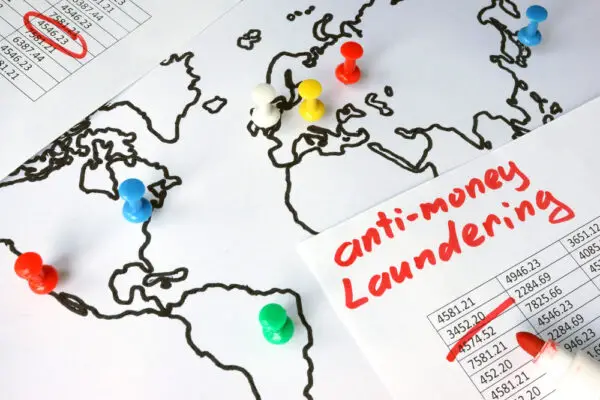Money laundering is the process of making illegally-gained proceeds appear legal. It’s a serious crime that can have significant legal and financial consequences. Here are some common signs that may indicate money laundering:
Frequent Large Transactions: Large deposits or withdrawals, especially in cash, can signal money laundering. This is especially true if the transactions have no legitimate purpose or are inconsistent with the customer’s business or occupation.
Overcomplicated Financial Activities: Money launderers often use complex transactions involving multiple banks, accounts, or countries to confuse and cover their tracks.
Rapid Movement of Money: Money quickly moves between accounts, especially across different banks or countries, which can signify money laundering.
Inconsistent Business Transactions: Transactions inconsistent with a customer’s normal business practices or with standard practices for their industry can be a sign of money laundering.
Overuse of Anonymity or Third Parties: Money launderers often use third parties, shell companies, or anonymous transactions to hide their identity and the source of their funds.
Lifestyle Inconsistent with Income: If a person’s lifestyle appears inconsistent with their income, it could be a sign that they are laundering money.
Reluctance to Provide Information: If a customer is reluctant to provide information about their business activities or provides information that is difficult to verify, it could be a sign of money laundering.
If you suspect money laundering, it’s important to report it to the appropriate authorities. Financial institutions and certain other businesses must report suspicious transactions to the government in many jurisdictions. It’s also a good idea to consult with a legal or financial professional if you’re unsure about a transaction or a customer’s behavior.
Please note that while these signs can indicate potential money laundering, they are not definitive proof. Legitimate transactions can sometimes appear suspicious, and not all suspicious transactions are illegal.
Money laundering is a serious criminal activity involving disguising illegal activities’ proceeds as legitimate funds. This process allows criminals to enjoy the benefits of their illicit gains without attracting attention from law enforcement agencies.
The consequences of money laundering are severe, including fines, imprisonment, and damage to the reputation of individuals and businesses found guilty of this crime.
To combat money laundering effectively, it is essential to understand its definition and recognize common signs that indicate its occurrence. Additionally, knowledge about the methods used to launder money and implementing preventative measures can help minimize the risk of becoming involved with illegal activities.
Staying informed and educated on money laundering trends and regulations can also aid in detecting suspicious financial transactions early on.
In this article, we will explore these topics in-depth to provide readers with a comprehensive guide on identifying money laundering effectively.

Understand the Definition and Consequences of Money Laundering
Money laundering is a serious crime involving concealing illegally obtained funds through complex financial transactions. This illegal activity can have severe legal consequences for those involved, including fines and imprisonment.
Money launderers attempt to make their ill-gotten gains appear legitimate by creating an intricate web of financial transactions that are difficult to trace.
The basic steps in money laundering typically involve placement, layering, and integration. Placement is the initial stage where criminals introduce their illegal profits into the financial system.
Layering involves disguising these funds by transferring them through multiple accounts or investments in different countries. The integration marks the final step, legitimizing these funds by reintroducing them into the economy as clean money.
Money laundering is a major problem across the world, causing significant harm to society at large. It facilitates criminal activities like drug trafficking and terrorism financing while undermining economic systems and stability.
Detecting money laundering requires close attention to suspicious financial activities and transactions, particularly those involving large sums of cash or unusual transfers between accounts or jurisdictions.
Recognize Common Signs of Money Laundering
One of the key indicators of illicit activity is when transactions are conducted using complex structures or mechanisms that obscure their true value and purpose. For instance, criminals may use multiple intermediaries, shell companies, or anonymous accounts to transfer funds across borders and avoid detection by authorities.
These convoluted arrangements can make it difficult for regulators to identify the source and destination of money flows and raise suspicions about the legitimacy of the underlying activities.
To help detect potential money laundering cases, financial institutions should be aware of some common signs that may indicate suspicious behavior. Here are three examples:
- Unusual transaction patterns: Watch out for transactions that deviate from typical customer behavior in frequency, size, type, or location. For example, if a customer suddenly starts making large cash deposits into their account without explaining where the funds came from or why they need them, this could suggest an attempt to launder money.
- Lack of transparency: Be wary of customers who refuse to provide adequate documentation or information about their identity, business operations, or sources of wealth. This lack of transparency can be a red flag indicating an attempt to hide illicit activities from scrutiny.
- High-risk sectors: Some industries are more prone to being used for money laundering than others due to their characteristics, such as high-volume cash transactions, low barriers to entry, and weak regulation or oversight. Examples include casinos, real estate agents/brokers/developers/builders/operators (REBs), and precious metal dealers.
Recognizing common signs of money laundering is crucial for identifying potential risks and taking appropriate action before any harm is done by being alert to unusual transaction patterns and lack of transparency.
High-risk sectors, among other indicators, financial institutions can protect themselves from becoming conduits for illegal activities while also contributing towards maintaining the integrity and stability of the global financial system.
Learn about the Methods Used to Launder Money
Money laundering is a pervasive issue in the financial world, and it involves various methods to disguise the source of illegally obtained funds.
Three common techniques to launder money include smurfing, structuring, and layering.
Smurfing involves breaking up large sums of money into smaller transactions that are difficult to trace while structuring entails making multiple deposits or withdrawals under the reporting threshold.
Layering involves creating complex financial transactions that obscure the origin of illicit funds.
Smurfing
The illicit practice of smurfing involves deliberately structuring small cash deposits by individuals or groups to avoid detection and circumvent anti-money laundering measures.
This technique breaks down large sums of money into smaller amounts below the reporting threshold, making it difficult for law enforcement agencies to track the source and destination of funds.
Smurfing activities can be carried out in various ways, such as making multiple transactions through different bank branches, using different accounts held by third parties or shell companies, or exchanging cash with other individuals.
The main objective is to conceal the true origin and purpose of the funds while avoiding detection by financial institutions and regulatory authorities.
Banks have implemented stricter controls and monitoring systems to combat this illegal activity to detect suspicious transactions, including those involving small amounts of cash.
However, surfers continue finding new ways to evade detection, highlighting the need for ongoing efforts to develop effective anti-money laundering strategies.
Structuring
Structuring, also known as smurfing, involves breaking down large sums of cash into smaller amounts to evade detection by financial institutions and regulatory authorities. This process is done to avoid triggering the reporting requirements set forth by the Bank Secrecy Act (BSA).
Financial institutions must report any transactions exceeding $10,000 in cash to FinCEN (Financial Crimes Enforcement Network), a U.S. Department of Treasury bureau.
Thus, structuring is considered a form of money laundering because it allows individuals or organizations to conceal illegal sources of funds by making them appear legitimate. This technique is commonly used by drug traffickers and criminals who receive large amounts of cash in illegal activities.
Structuring can be detected through various means, such as suspicious patterns of withdrawals or deposits, round sum transfers, and frequent transactions just below the $10,000 threshold. Financial institutions play a critical role in detecting and reporting these activities to prevent money laundering from occurring.
Layering
Layering, also known as integration, is a sophisticated technique used in the second stage of money laundering, where multiple transactions are conducted to obscure the origin and ownership of the funds.
Layering aims to make it difficult for law enforcement agencies to trace the source of funds and identify any criminal activity involved. In this process, criminals often move money around different accounts or jurisdictions through complex financial transactions.
The table below highlights some standard techniques used in layering:
| Technique | Description |
|---|---|
| Wire transfers | Moving funds electronically between banks or countries |
| Investment in securities | Investing in stocks, bonds, or other securities |
| Cash conversion | Changing cash into monetary instruments such as traveler’s checks or cashier’s checks |
| Offshore accounts | Opening bank accounts in foreign countries with strict privacy laws |
Banks and financial institutions must be vigilant against these practices and implement robust anti-money laundering policies and procedures.
Implement Preventative Measures
One effective approach to reducing the risk of money laundering is implementing preventative measures that target key areas of vulnerability within an organization or industry.
These measures can include implementing robust Know Your Customer (KYC) procedures, conducting regular internal audits and risk assessments, and providing anti-money laundering training to staff members.
KYC processes help organizations verify the identity of their clients and ensure that they are not involved in any criminal activities. By conducting regular internal audits, organizations can identify any weaknesses in their existing systems and take corrective action promptly.
In addition to KYC processes and regular audits, another important preventative measure is to provide anti-money laundering training to staff members at all levels of an organization.
This training should cover topics such as recognizing suspicious transactions, reporting them appropriately, and what legal obligations exist under relevant laws and regulations.
Ensuring that all staff members understand these issues thoroughly, organizations can reduce the likelihood of money laundering occurring on their watch. Overall, preventing money laundering requires a multi-faceted approach that targets key areas of vulnerability within an organization or industry.
Implementing robust KYC procedures, conducting regular internal audits, and providing anti-money laundering training to all staff members, organizations can significantly reduce their exposure to this type of financial crime.
Stay Informed and Educated on Money Laundering Trends and Regulations
Businesses and financial institutions need to implement preventative measures to prevent money laundering effectively. These measures may include using advanced software systems and tracking protocols to detect suspicious transactions or patterns in financial activity. However, while preventive measures are important, they are not always enough.
To stay ahead of money laundering trends and regulations, staying informed and educated on the subject is crucial. This includes regularly monitoring industry news and updates from regulatory bodies such as the Financial Action Task Force (FATF) or the International Monetary Fund (IMF).
It also involves understanding key terms and concepts related to money laundering, such as ‘placement,’ ‘layering,’ and ‘integration.’
Staying informed about current trends in money laundering, businesses can better identify potential risks within their own operations. They can adjust their strategies by implementing additional safeguards or training employees on best practices for detecting suspicious behavior.

Frequently Asked Questions
What is the maximum penalty for money laundering?
The maximum penalty for money laundering varies by jurisdiction and can range from fines to imprisonment. In the United States, the maximum penalty is 20 years in prison and a fine up to $500,000 or twice the value of the illicit funds involved.
How long does it typically take for authorities to investigate and prosecute a money laundering case?
The duration of investigating and prosecuting a money laundering case varies depending on the complexity and scope of the investigation. It can take several months to years, involving multiple agencies and jurisdictions, extensive evidence gathering, and legal proceedings.
Are there any industries or businesses that are particularly susceptible to money laundering?
Some industries and businesses are more vulnerable to money laundering due to the nature of their operations. Examples include financial institutions, casinos, real estate, and high-value commodity trading. However, any business can be used for this purpose.
Can individuals be held liable for unknowingly facilitating money laundering?
Individuals can be liable for unknowingly facilitating money laundering, as the law imposes a duty of care to identify and report suspicious activities. Ignorance of the law is not a defense, and failure to comply may result in criminal or civil penalties.
What is the process for reporting suspected money laundering activity to the authorities?
Individuals should contact their country’s financial intelligence unit or law enforcement agency to report suspected money laundering. They may also consider consulting with a legal professional to ensure compliance with relevant regulations and protocols.

Conclusion
Individuals and organizations need to implement preventative measures, such as conducting background checks and monitoring financial transactions, to avoid involvement in illegal activities related to money laundering.
Staying informed and educated on trends and regulations related to money laundering can also help individuals take proactive steps toward preventing it. Detecting money laundering is crucial in maintaining a transparent financial system that promotes ethical business practices.
Recognizing the red flags of potential illicit activity and implementing preventative measures, individuals can protect themselves from legal repercussions and contribute towards promoting a fairer economic environment. As such, efforts toward identifying money laundering should be ongoing and prioritized by governments and private entities.

Chris Ekai is a Risk Management expert with over 10 years of experience in the field. He has a Master’s(MSc) degree in Risk Management from University of Portsmouth and is a CPA and Finance professional. He currently works as a Content Manager at Risk Publishing, writing about Enterprise Risk Management, Business Continuity Management and Project Management.

